User Manual
V 1.00
Digital Projector
Portable Series | GV31

2
Product support
You are strongly recommended to upgrade the product to the latest
firmware version and refer to the most up-to-date user manual to make
best use of the product.
This document aims to provide the most updated and accurate information
to customers, and thus all contents may be modified from time to time
without prior notice. Please visit the website for the latest version of this
document and other product information. Available files vary by model.
1. Make sure your computer is connected to the Internet.
2. Visit the local website from Support.BenQ.com. The website layout and
content may vary by region/country.Look for the following regularly to
get the most up-to-date information.
• User manual and related document
• Firmware and application
• Frequently asked questions
Servicing
• If misuse or other accident occurs, contact qualified service personnel
for servicing.
• Contact your place of purchase or visit the local website from Support.
BenQ.com for more support.
Support.BenQ.com
3
Q&A index
Start with the topics you are interested in:
Setup
How do I set up the projector and turn it on?
Choosing a location 21
Powering on and initial setup 28
Image adjustment
How do I adjust the focus of the projected image?
Adjusting the projection angle 33
Fine-tuning the image clarity 34
How do I t the projected image to the screen?
Keystone 34
Usage
How do I project wirelessly?
Wireless projection 39
How do I play music via the projector?
Making your projector a wireless speaker 41
Maintenance and product support
What should I do if I don't plan to use the projector for a long
time?
Storing the projector 53
4
Table of Contents
Product support ........................................................................................2
Servicing .......................................................................................................2
Q&A index .....................................................................................................3
Safety instructions .................................................................................... 7
Package contents ................................................................................... 10
Introduction ................................................................................................11
Projector overview .........................................................................................11
Overview ........................................................................................................ 11
I/O ports ....... .................................................................................................. 13
Dimensions .................................................................................................... 14
Projector connections ................................................................................ 15
Wireless connection (via ATV Dongle) ........................................................ 15
Wired connection (HDMI port) ..................................................................... 15
Wired connection (USB-A port) ................................................................... 15
Wired connection (USB-C port) .................................................................... 15
Remote control (projector remote control only) ........................... 18
Remote control effective range............................................................. 19
Setting to power on projector by remote control .......................... 19
Turning remote control backlight on/off ......................................... 20
Installation ................................................................................................. 21
Choosing a location ....................................................................................21
Obtaining a preferred image size ........................................................23
Projection dimensions .................................................................................. 23
Using the projector in an outdoor setting ........................................ 24
Installing the ATV dongle ........................................................................ 25
Power supply .................................................................................................27
Charging the battery ..................................................................................... 27
Getting started ........................................................................................ 28
Powering on and initial setup ................................................................ 28
5
Power LED indicator ...................................................................................... 29
Power menu options ................................................................................. 30
Shutting down the projector ................................................................... 31
Upgrading your projector ...................................................................32
Adjusting the projected image ........................................................33
Adjusting the projection angle ............................................................. 33
Fine-tuning the image clarity ............................................................... 34
Fitting the image to your screen .......................................................... 34
Keystone ........................................................................................................ 34
Changing the input source ........................................................................... 35
Watching streaming videos ..............................................................36
ATV home screen........................................................................................ 36
Choosing a proper picture mode for video streaming ...............37
Choosing a proper sound mode for video streaming .................37
Customizing a sound mode ......................................................................... 38
Projection ...................................................................................................39
Wireless projection .................................................................................... 39
Wired projection .......................................................................................... 39
Playing music with your projector ................................................... 41
Making your projector a wireless speaker ........................................ 41
Turning the screen off during music playback ............................................ 42
Playing multimedia les from a USB ash drive .......................44
Power delivery to a USB-C device ..................................................45
USB-C power delivery notice .................................................................45
Menu navigation ....................................................................................46
Brightness ......................................................................................46
Picture Mode .................................................................................. 47
Sound Mode .................................................................................... 47
Picture .............................................................................................48
Sound ..............................................................................................49
6
Focus ...............................................................................................49
Installation .....................................................................................50
Power Mode .....................................................................................51
System ............................................................................................ 52
Maintenance ............................................................................................ 53
Care of the projector ................................................................................. 53
Cleaning the lens ........................................................................................ 53
Storing the projector ................................................................................. 53
Transporting the projector .....................................................................54
Light source information .........................................................................54
Extending LED life ........................................................................................54
Troubleshooting .......................................................................................... 55
Specications .......................................................................................... 57
Projector specications ........................................................................... 57
Timing chart ..................................................................................................59
Video timings ...............................................................................................60
Supported le formats .............................................................................. 61
Appendix ....................................................................................................62
Working with a tripod (purchased separately) ............................ 62
Pairing with a new remote control ...................................................... 63
Copyright & disclaimer .......................................................................64
Copyright .......................................................................................................64
Disclaimer ......................................................................................................64
Warranty.........................................................................................................65
Statement regarding hyperlinks and third-party websites ....65
BenQ ecoFACTS ........................................................................................... 66
7
Safety instructions
Your projector is designed and tested to meet the latest standards for
safety of information technology equipment. However, to ensure safe use
of this product, it is important that you follow the instructions mentioned
in this manual and marked on the product.
1. Please read this user manual before you operate your projector.
Keep this manual in a safe place for future reference.
2. Always place the projector on a level, horizontal surface during
operation.
• Do not place the projector on an unstable cart, stand, or table as it
may fall and be damaged.
• Do not place inflammables near the projector.
Do not use if tilted at an angle of more than 10 degrees left to
right, nor at angle of more than 15 degrees front to back.
3. Do not store the projector on end vertically. Doing so may cause the
projector to fall over, causing injury or resulting in damage.
4. Do not place this projector in any of the following environments.
• Space that is poorly ventilated or confined. Allow at least 50 cm
clearance from walls and free flow of air around the projector.
• Locations where temperatures may become excessively high,
such as the inside of a car with all windows rolled up.
• Locations where excessive humidity, dust, or cigarette smoke may
8
contaminate optical components, shorten the projector’s lifespan
and darken the screen.
• Locations near fire alarms.
• Locations with an ambient temperature above 40°C /104°F
• Locations where the altitudes are higher than 2000 m (6562 feet).
0 m
(0 feet)
2000 m
(6562 feet)
5. Do not block the vents holes while the projector is on (even in power-
saving mode).
• Do not cover the projector with any item.
• Do not place the projector on a blanket, bedding or any other soft
surface.
6. In areas where the mains power supply voltage may fluctuate by
±10 volts, it is recommended that you connect the projector through
a power stabilizer, surge protector or uninterruptible power supply
(UPS) as appropriate to your situation.

9
7. Do not step on the projector or place any objects upon it.
8. Do not place liquids near or on the projector. Liquids spilled into
the projector will void your warranty. If the projector does become
wet, disconnect it from the power point and call BenQ to have the
projector repaired.
9. Do not look straight into the projector lens during operation. It may
harm your sight.
10. Do not operate the projector LED beyond the rated LED life.
Excessive operation of LEDs beyond the rated life could cause LEDs
to break on rare occasions.
10
11. Do not attempt to disassemble this projector. There are dangerous
high voltages inside which may cause death if you should come into
contact with live parts.
Under no circumstances should you ever undo or remove any other
covers. Refer servicing only to suitably qualified professional service
personnel.
Warning
• Please keep the original packing for possible future shipment.
• If you need to pack your projector after use, adjust the projection lens to an appropriate position,
put the lens cushion around the lens, and fit the lens cushion and projector cushion together to
prevent damage during transportation.
12. When you think service or repair is required, take the projector only
to a suitably qualified technician.
Moisture condensation
Never operate the projector immediately after moving it from a cold
location to a hot location. When the projector is exposed to such a change
in temperature, moisture may condense on the crucial internal parts. To
prevent the projector from possible damage, do not use the projector for at
least 2 hours when there is a sudden change in temperature.
Avoid volatile liquids
Do not use volatile liquids, such as insecticide or certain types of cleaner,
near the projector. Do not have rubber or plastic products touching the
projector for a long time. They will leave marks on the finish. If cleaning
with a chemically treated cloth, be sure to follow the cleaning product’s
safety instructions.

11
Disposal
This product contains the following materials which are harmful to human
bodies and environment.
• Lead, which is contained in solder.
To dispose of the product, consult your local environment authorities for
regulations.
Note
• The illustrations and the images shown in this document are for your reference.
• The actual content may vary by the product supplied for your region.
10
Package contents
Carefully unpack and verify that you have all of the items shown below.
Some of the items may not be available depending on your region of
purchase. If any of these items are missing, please contact your place of
purchase.
GV31 ATV dongle (QS02) Projector's remote control
(With two AAA batteries)
Quick start guide Regulatory statements Warranty card
(Varies by region)
Power adapter Power cord
(Varies by region)
Base
Note
• LED life results will vary depending on environmental conditions and usage. Actual product’s fea-
tures and specications are subject to change without notice.
• LED replacement is not user-serviceable. When it is needed, please contact the service center.
• Some of the accessories may vary from region to region.
• The warranty card is only supplied in some specic regions. Please consult your dealer for detailed
information.
• Use original accessories to ensure compatibility.
• Power cord plug type may change based on regional requirements.
11
Introduction
Projector overview
Overview
1
2
3
4
5
6
7
8
9
10
11
12
13
No. Descriptions
1. Strap
2. Volume up button
3. Left speaker and vent
4.
I/O ports
• See "I/O ports" on page 13 for details.
• See "Projector connections" on page 15 for connections.
5. Input source button
6. Volume down button
7. Power button and LED
13
I/O ports
123 4 5
6
No. Descriptions
1.
USB Type-A port
See the following for details.
• "Playing multimedia files from a USB flash drive" on page 44
• Power supply. See "Specifications" on page 57.
2.
HDMI port (Version 1.4b)
See "Wired connection (HDMI port)" on page 15 for details.
3.
USB Type-C port
See the following for details.
• "Power supply" on page 27
• "Upgrading your projector" on page 32
• "Wired projection" on page 39
• "Playing multimedia files from a USB flash drive" on page 44
• "Power delivery to a USB-C device" on page 45
4. 3.5” audio output jack
5. Power adapter port
6. Internal HDMI port (exclusively for QS02)

14
Dimensions
With Base: 131.3 (W) x 203.2 (H) x 191.4 (D) mm (5.2 x 8 x 7.5 in)
Without Base: 104 (W) x 191.4 (H) x 191.4 (D) mm (4.1 x 7.5 x 7.5 in)
15
Projector connections
You can connect your device to the projector in various ways to project
video content.
Wireless connection (via ATV Dongle)
• Smartphone, tablet, laptop/PC (see "Wireless projection" on page 39)
• Bluetooth devices (speakers, headphone, mouse, etc.)
Before making any wireless connections, be sure to:
• Install the provided ATV dongle for wireless connection.
• Place the projector within range of the wireless AP you plan to connect
it to.
Wired connection (HDMI port)
• A/V device
• Smartphone, tablet, laptop/PC
Wired connection (USB-A port)
• USB-A flash drive (see "Playing multimedia files from a USB flash drive"
on page 44)
Wired connection (USB-C port)
• Smartphone, tablet, laptop/PC (see "Wired projection" on page 39)
• Power bank (see "Power supply" on page 27 and "Power delivery to a
USB-C device" on page 45)
• USB-C flash drive (see "Playing multimedia files from a USB flash drive"
on page 44)
Before making any wired connections, be sure to use the correct cable
for each source and that it is plugged in securely. Connection with USB-C
cables/devices certified by USB-IF may increase compatibility.
16
a
c
d
b
Speakers
A/V device
Wireless Connections
USB drive
Notebook or
desktop computer
Certified devices with
USB-C DisplayPort
QS02
ATV dongle
Wireless AP
USB drive
No. Descriptions No. Descriptions
a.
USB flash drive for media reader
c.
Certified USB-C cable
b.
HDMI cable
d.
Audio cable

17
Note
• In the connections above, some cables may not be included with the projector (see "Package con-
tents" on page 10). They are commercially available from electronics stores.
• The connection illustrations are for reference only.
• If the selected video image is not displayed after the projector is turned on and the correct video
source has been selected, check that the video source device is turned on and operating correctly.
Also check that the signal cables have been connected correctly.
• The built-in speaker(s) will be muted when the AUDIO OUT jack is connected.
• The illustration above is for reference only.
18
Remote control
(projector remote
control only)
11
10
3
4
5
6
7
8
9
13
12
1
2
14
15
16
18
17
19
20
21
No. Descriptions
1. Microphone
2.
Power
3.
Source
4. Arrow keys
5. OK
No. Descriptions
6.
Back
7.
Mute
8.
Rewind
9.
Wireless speaker mode
10.
Focus
11.
Geometry setting:
Keystone
12.
Projector menu
13.
Voice Search
14.
Android TV home screen
15.
Android TV Settings
16.
Volume up
17.
Volume down
18.
Fast forword
19.
Play/Pause
20.
Sound mode
21.
Picture mode
19
Remote control effective range
The projector has one IR remote control sensor located at the front of the
projector with a range of 8 meters (~26 feet) at an angle of 30 degrees (left
and right) and 20 degrees (up and down). Prior to remote control pairing
process during the setup wizard (see "Powering on and initial setup" on
page 28), the remote control can only be used either by pointing it
directly at the IR sensor or by reflecting the IR signal off of a wall/screen,
making sure that there are no obstacles between the remote control and
the IR sensor on the projector.
Once the remote control has been paired to the ATV dongle installed in the
projector, you will be able to use it at any angle within a range of 8 meters
(~26 feet).
Note
Voice search functionality on the remote control is only available after the remote control has been
paired to the projector during the setup wizard process. See "Powering on and initial setup" on page
28 for more details.
Setting to power on projector by
remote control
Powering on the projector via the remote control is not enabled by default.
To enable it, press the > System > Use remote control to power on.
Once enabled, the projector scans for remote control signals when it is
powered off and may drain battery power gradually.

20
Turning remote control backlight on/
off
With the remote control backlight, you can see the buttons when they are
pressed in the dark.
Press and hold the Mute button and Volume up button on the
remote control to turn the backlight function on/off. To save battery power,
you can turn off the backlight.
21
Installation
Choosing a location
Before choosing an installation location for your projector, take the
following factors into consideration:
• Size and position of your screen
• Electrical outlet location
• Location and distance between the projector and the rest of your
equipment
• Location and distance between the projector and the wireless access
point
You can install your projector in the following ways:
• Front Table
Select this location with the projector placed
near the floor in front of the screen.
This is the most common way to position the
projector for quick setup and portability.
Turn on the projector and select the following
settings in the projector’s settings menu. See
"Installation" on page 50 for more details:
Installation > Projector Position > Front Table
• Front Ceiling
Select this location with the projector elevated
near the ceiling in front of the screen.
Turn on the projector and select the following
settings in the projector’s settings menu. See
"Installation" on page 50 for more details:
Installation > Projector Position > Front Ceiling
Note
The projector does not feature ceiling mount components/
equipment. When choosing to use a ceiling location, you must
place it on an elevated and even shelf purchased separately. Make
sure the shelf is stable enough to support the projector’s weight.
Secure the shelf properly and keep the projector from falling.
22
• Rear Table
Select this location with the projector placed
near the floor behind the screen.
Turn on the projector and select the following
settings in the projector’s settings menu. See
"Installation" on page 50 for more details:
Installation > Projector Position > Rear Table
Note
A special rear projection screen is required.
• Rear Ceiling
Select this location with the projector elevated
from the ceiling behind the screen.
Turn on the projector and select the following
settings in the projector’s settings menu. See
"Installation" on page 50 for more details:
Installation > Projector Position > Rear Ceiling
Note
• A special rear projection screen is required.
• The projector does not feature ceiling mount components/equip-
ment. When choosing to use a ceiling location, you must place
it on an elevated and even shelf purchased separately. Make
sure the shelf is stable enough to support the projector’s weight.
Secure the shelf properly and keep the projector from falling.
23
Obtaining a preferred image size
The distance from the projector lens to the screen, the zoom setting, and
the video format each factors in the projected image size.
Projection dimensions
The screen aspect ratio is 16:9 and the projected picture is in a 16:9
aspect ratio
.
H
16:9 Screen Diagonal
Screen
Center of lens
Distance from Screen
W
Vertical Offset
Screen size
W (mm) H (mm) Distance from screen (mm)
Inch mm
30 762 664 374 797
40 1016 886 498 1063
50 1270 1107 623 1328
60 1524 1328 747 1594
70 1778 1550 872 1860
80 2032 1771 996 2125
90 2286 1992 1121 2391
100 2540 2214 1245 2657
110 2794 2435 1370 2922
120 3048 2657 1494 3188
For example, if you are using a 100-inch screen, the recommended
projection distance is 2657 mm.
If your measured projection distance is 2391 mm, the projected screen
size is 90-inch.

24
Note
• All measurements are approximate and may vary from the actual sizes.
• To optimize your projection quality, we suggest referring to the values listed in the non-gray rows
for projection.
• BenQ recommends that if you intend to permanently install the projector, you should physically
test the projection size and distance using the actual projector in situ before you permanently
install it, so as to make allowance for this projector’s optical characteristics. This will help you
determine the exact mounting position so that it best suits your installation location.
Using the projector in an outdoor
setting
The projector is designed mainly for indoor use but its portable design
also allows it to support occasional outdoor use. When using the projector
outdoors, the following items are suggested to enhance the viewing
experience:
• Install the projector on a tripod if there is no flat surface to place the
projector. See "Working with a tripod (purchased separately)" on page
62 for more details.
• Set the picture mode to the most suitable setting (e.g. Bright for a
brightly lit environment). See "Picture Mode" on page 47 for more
details.
25
Installing the ATV dongle
1. Find the provided ATV dongle in the packaging.
2. Place the projector on a flat and stable surface covered by a protective
sheet with its right speaker facing up. Make sure the rear speaker is
facing you with the strap on the right.
3. Using the thumbs of both hands push the edge of the right speaker
cover so that it slides forwards and then remove the cover from the
projector.
4. Peel off the adhesive sponge covering the micro USB power cable
compartment.
5. Orient the ATV dongle so that the BenQ logo faces up, then connect the
micro USB power cable to the port at the rear side of the dongle and
then push the dongle into the HDMI connector on the projector until
you hear a click.

26
2
1
3
6. Align the right speaker cover over the projector so that the hooks on
the cover line up with the corresponding openings on the projector, and
then re-install the top cover onto the projector.
27
Power supply
Supply power to your projector by one of the following methods.
• (Recommended) Via the provided power adapter and power cord. The
Power Mode is switched to Normal or the previous mode you set.
• Via a power bank or power adapter with USB-C connector or
USB-C cable that are certified by USB-IF. See PD in information in
"Specifications" on page 57 for details. The Power Mode is switched
to Normal or the previous mode you set.
• Via the built-in battery after it is fully charged. The projector's
Power Mode is switched to Low Power Consumption automatically.
Note
• The USB-C port is able to provide power to connected devices. See "Power delivery to a USB-C
device" on page 45 for more information.
• The USB-A port is able to provide power to connected devices. See "Specications" on page 57.
• Please only use the supplied power adapter to avoid possible dangers such as electric shock and
re.
Charging the battery
1. Make sure the appropriate plug has been properly assembled, and then
connect the adapter to the power adapter port.
2. Connect the power cord to a power outlet.
2
1
3
The power LED indicator will illuminate according to its charge status, for
a full charge wait until the indicator lights up solid green (see "Power LED
indicator" on page 29 for more information on LED behavior). It takes
about 3 hours.
28
Getting started
Powering on and initial setup
1. Choose a preferred location and image size as instructed in "Choosing
a location" on page 21. Make sure the ATV dongle has been installed.
See "Installing the ATV dongle" on page 25 for more details.
2. Install the remote control's batteries.
Before you can begin to use the remote control, you must install the
supplied batteries into the remote control.
• Slide the battery cover outwards.
• Insert the batteries in the orientation shown below.
• Slide the battery cover back onto the remote control.
Note
Avoid leaving the remote control and batteries in an excessively hot or humid environment like the
kitchen, bathroom, sauna, sunroom or in a closed car.
3. Connect power to the projector. If you are starting up the projector for
the first time, charge the battery or supply power to the projector until
the power LED lights up in green. See "Charging the battery" on page
27 for more information.
Press and hold the power button
on the projector for 3 seconds.
The power LED will flash green slowly.
29
2
1
3
3 seconds
Note
• When supplying power directly to the projector via the supplied power adapter please use the
supplied power cable to avoid possible dangers such as electric shock and re.
• Prior to pairing the remote control to your projector you must ensure that your remote control is
in range of the projector’s IR sensor. See "Remote control effective range" on page 19 for more
details.
• Powering on via the remote control is not enabled by default. To enable it, go to System >
Use remote control to power on.
• Powering on via the remote control will not work if you have not completed the setup wizard pro-
cedure or if the projector’s battery level is below 5%.
4. Power on the projector and follow the on-screen instructions to
complete the initial setup. When you're promted to set up your remote,
select "Not now" to proceed. You can refer to the QS02 user manual
from Support.BenQ.com for more information.
5. Check if an updated firmware is available for your product. Refer to
"Upgrading your projector" on page 32.
6. Go for a preferred scenario.
• "Watching streaming videos" on page 36
• "Projection" on page 39
• "Playing music with your projector" on page 41
Power LED indicator
Scenario LED status Power status
Turning on/off
Flashing green Turning on/off properly
Flashing red Low battery (below 5%)
Charging with adapter
Solid green Fully charged
Solid red Charging
30
Scenario LED status Power status
Battery mode
• Power on: Solid
• Power saving/Audio
only: Breathing
Solid/Breathing
green
Battery capacity: 60% -
100%
Solid/Breathing
red
Battery capacity: 21% - 59%
Flashing/
Breathing red
Battery capacity: < 20%
Power menu options
Press the button on the remote control or projector to bring up the
power menu.
Item Description
Power Off Sets to power off the projector.
Audio-Only Mode
Sets to turns off the screen while the music
playback continues. See "Turning the screen off
during music playback" on page 42 for more
information.
Power Saving
Sets the projector and the ATV dongle to power
saving mode when they are not in use. To disable
Power Saving mode, press the
button.
31
Shutting down the projector
Press and hold the power button on the projector for over 3 seconds
and the projector will shut down directly.
The power LED will flash green. The fans may continue to run in order to
cool the system.
If the projector will not be used for an extended period, unplug the power
cable from the power outlet and remove the batteries from the remote
control.
Note
Short pressing the power button on the projector or remote control will trigger a shutdown
confirmation box. Under this condition, press the power button again to shut down the projector.
2
3
1
3 seconds

32
Upgrading your projector
It is suggested that you update the projector with the latest version of the
firmware to optimize the user experience.
How-to Video
Firmware Upgrade
1. Visit Support.BenQ.com and download the new firmware files (if
available) of your projector. Save the firmware files to a USB flash drive
in FAT32 disk format. You should download the latest user manual for
reference as well.
2. Keep stable power supply to the projector via power adapter. Do not
power off the projector.
3. Connect the USB flash drive to the USB-C port.
4. Go to System > System Update > USB Update on your projector to start
the upgrade. Wait until you are instructed to complete the initial setup.
The upgrade is complete.
Note
Check if there are updated firmware files and user manual of QS02 ATV dongle from Support.BenQ.
com. Find out the updates from the upgrade notice. If a new firmware version is available, you are
recommended to upgrade the dongle for best performance.
33
Adjusting the projected image
Adjusting the projection angle
The projector features a base that holds the projector and allows you to
adjust the projection angle.
Place the projector properly on the base until it clicks, and rotate the
projector to adjust the projection angle.
135°
Note
• The maximum angle of adjustment is 135 degrees.
• If the screen and the projector are not perpendicular to each other, the projected image becomes
trapezoidal. To correct this, see "Keystone" on page 34 for details.
• When the projector is on, DO NOT place down the projector with its left or right vents facing down
as this will block the vents.
34
Fine-tuning the image clarity
To sharpen the picture, adjust the focus.
• Real-time focus adjustment: You may allow the projector to
automatically focus the image in real-time via the settings menu by
configuring Focus > Real Time Adjustment to On. When the projector
is moved or the projection distance is changed, the function will be
performed automatically. The effective distance from the projection
lens to the screen is 3.2 meters. See "Focus" on page 49 for more
information.
• Auto focus: Press the focus button
on the remote control and
the projector will automatically focus the image. When the focus is
completed, press
/ to leave.
• Manual focus: You may also manually focus the image by either
pressing the focus button
on the remote control and pressing the
left
or right buttons on the remote control while the focus guide
is still on the screen, or by using Focus > Manual Focus in the settings
menu. See "Focus" on page 49 for more information.
Note
Do not look into the lens while the light is on. The strong light from the lens may cause damage to
your eyes.
Fitting the image to your screen
Keystone
The keystone effect refers to the situation where the projected image
is noticeably wider at the top / bottom / left / right. It occurs when the
projector is not perpendicular to the screen. The screen automatically

35
performs keystone correction as the projector moves.
• Auto Vertical Keystone: Available from Installation >
Auto Vertical Keystone in the settings menu. When the projector
is moved or the projection angle is changed, the function will be
performed automatically.
• Manual Keystone: Available by pressing the
button on the remote
control or from Installation > Vertical Keystone Correction. Simply
follow the on-screen instructions to make adjustments.
When you are done making the adjustments, press / to save your
changes and return to the previous menu.
Changing the input source
By default, the projector will enter the Android TV interface any time it is
powered on. Once powered on, when a device is connected to one of its
input ports the projector will automatically switch over to that input source.
To switch between input sources and Android TV, press the source button
on the remote control and select the desired input source from the
source menu.
You can also press the home button on the remote control to return to
the Android TV home screen at any time.
36
Watching streaming videos
Make sure the ATV dongle (QS02) has been installed and connected to a
wireless network properly. Android TV is the projector’s operating system
that allows you to project videos wirelessly and use streaming apps.
Note
For the ATV dongle (QS02) user manual, visit Support.BenQ.com.
ATV home screen
Upon initial startup or when the input source is set to ATV the projector
will display the Android TV interface. If the projector is projecting from
a source, you can return to Android TV by pressing the
key on your
remote control or by selecting ATV in the input source menu.
The Android TV home screen features following items:
8:28
1
1 32 8 95 6
Search Discover AppsHome
4 7
Note
Actual screen may vary based on your Android TV version.
No. Item Description
1
Google Assistant
Press the Google Assistant button on your
remote control to talk to Google.
2
Home Access to Android TV Home screen.
3
Discover Access to personalized recommendations.
37
No. Item Description
4
Apps Access to all the installed apps and Google Play.
5
Recommended
apps/My favorites
• Access to the recommended apps or video
on demand services.
• Access to the apps that have been added to
favorites by the Bookmark key.
6
Recommended
content
Access to the content recommended by the
specified channel/streaming service.
7
Notification Access to notifications.
8
Settings Access to Android settings menus.
9
System time Displays the time.
Choosing a proper picture mode for
video streaming
You are provided with a variety of picture modes for different scenarios
in Picture Mode. Press the
button on the remote control for options.
Usually Cinema and Living Room are recommended for watching movies.
See "Picture Mode" on page 47 for more information.
Choosing a proper sound mode for
video streaming
In general, you can select a sound mode from Sound Mode to suit your
scenario. Press the button on the remote control for options. As
Cinema Extra Bass is recommended for movie watching, more options
are provided to enhance your cinematic experience. See "Sound Mode" on
page 47 for more information.

38
Customizing a sound mode
1. Go to Sound > User.
2. Adjust the frequency as desired.
3. Press
/ on the remote control to save the changes and exit.
To apply the customized sound mode, press the
button on the remote
control and select User.
Note
Press Sound > Reset Audio Settings to reset audio settings to factory defaults.

39
Projection
Wireless projection
Wireless projection is available only after the supplied ATV dongle (QS02)
is installed, and the projector and your device are connected to the same
wireless network. Refer to the QS02 user manual from Support.BenQ.com
or scan the following QR code for instructions on how to perform wireless
projection.
How-to video
Wireless projection
Wired projection
Using an HDMI or certified USB-C 3.0 cable you can connect a device that
is equipped with HDMI or DisplayPort capabilities to broadcast videos and
images on the projector.
Note
Not all devices with a USB-C port have DisplayPort functionality. Check your device’s documentation
for clarification.
To connect a device with HDMI or USB-C with DisplayPort:
1. Connect the device to the HDMI or USB-C port on the projector with
a certified cable. A pop-up notification will appear indicating that a
device is connected.
2. Confirm whether you want to project video from the device. The video
from the device will be displayed once the signal from the device is
detected.
Note
If no signal is detected or the signal is interrupted, a message will appear, check the cable
connection again.
3. Use the source menu or press the home button to exit and go back
to the Android TV home screen.
4. If the device remains connected and you want to project its video

40
again, press the source button , and then select the corresponding
port in the source menu.
Note
• Some computers feature HDMI ports that do not transmit audio, in such cases a separate audio
cable must be connected to the projector.
• Some laptops do not turn on their external video ports when connected to a projector. Usually a
key combination like Fn + F3 or CRT/LCD key turns the external display on/off. Locate a function
key labeled CRT/LCD or a function key with a monitor symbol on the laptop. Press Fn and the la-
beled function key simultaneously. Refer to your laptop’s documentation to discover your laptop’s
key combination.
Tip
Your projector features video/audio transfer and power delivery from the USB-C port. With this
feature, you can charge your gaming console (with USB-C video output) directly during gaming
without any other docking. See "Power delivery to a USB-C device" on page 45 for details.
41
Playing music with your
projector
With the built-in speakers, you can enjoy music playback via the projector
without a projection screen. The projector can work as an ordinary speaker
or a wireless speaker.
Making your projector a wireless
speaker
1. Make sure the ATV dongle is installed properly (see "Installing the ATV
dongle" on page 25).
2. Power on the projector (see "Powering on and initial setup" on page
28).
3. Press the wireless speaker mode
button on the remote control or
press the input source
button > Wireless Speaker. The projector will
stop projecting and switch over to wireless speaker mode.
4. Connect your mobile device and the projector (with the QS02 ATV
dongle installed) to the same wireless network.
5. Launch the music app on your mobile device and use the casting
function through Chromecast. Find QS02 as the casting device to enjoy
music streaming.
42
Turning the screen off during music playback
You can enjoy music playback via the projector without a projection
screen.
Press the
button on the remote control or projector, and select the
Audio-Only Mode to switch the projector to audio-only mode. The screen
is turned off while the music playback continues.
To stop the playback or to perform other operations, press any key on the
remote control to bring the projection screen back.
Connecting the projector to an
external Bluetooth speaker /
headphone
Available only when the input source is ATV.
1. Make sure the ATV dongle is installed properly (see "Installing the ATV
dongle" on page 25).
2. Power on the projector (see "Powering on and initial setup" on page
28).
3. Press the
button on the remote control.
4. Select Remotes & Accessories.
5. Select Add Accessory.
6. Activate Bluetooth-pairing mode on the speaker or headphones.
7. Select the speaker or headphones from the device list shown on
screen.
8. Select Pair.
When the projector and speaker or headphones have successfully

43
connected, the device will be labelled as connected in the
Network & Internet. You can now output the audio from the ATV to the
speaker or headphone.
Note
• This function is available only when the input source is set to ATV. Even when the projector is
switched to other input sources, such as HDMI, as ATV is still running in the background, it will
continue to transmit audio from ATV to the connected Bluetooth speaker or headphones.
• The projector does not support automatic re-connections with previously paired devices. In order
to re-connect to a paired device or connect to another device, repeat the steps above.

44
Playing multimedia les from a
USB ash drive
To play media files stored on a USB flash drive, you must make
connections and settings properly.
1. Make sure the ATV dongle is installed properly (see ""Installing the ATV
dongle" on page 25).
2. Connect your USB flash drive to the USB-A or USB-C port of the
projector.
3. Press the source button
on the remote control and select USB in
the source menu.
4. Follow the on-screen instructions. Click Apps from the ATV home
screen.
5. Launch a media reader app to access the multimedia files stored on
your USB flash drive. Supported file formats for playback may vary by
app.

45
Power delivery to a USB-C
device
Available only when the projector is supplied power via the included power adapter.
With the power delivery function, your projector is able to supply power to
a connected USB-C device certified by USB-IF.
Supported USB-C power delivery:
• 5V/2A
• 9V/2A
• 12V/1.5A
• 15V/1.2A
USB-C power delivery notice
• The information is based on the standard testing criteria and is
provided for reference. The compatibility is not guaranteed as the user
environments vary. When a separately purchased USB-C cable is used,
make sure the cable is certified by USB-IF and is full-featured, with
power delivery function.
• A connected device needs to be equipped with a USB-C connector that
supports charging function via USB power delivery.
• If the connected device requires more than the power supplied by your
projector for operation or for boot up (when the battery is drained), use
the original power adapter that came with the device.

46
Menu navigation
To let you make various adjustments or settings on the projector, the
projector provides a settings menu. To access the menu, either press the
button on the remote control.
Note
For settings related to the system including wireless connection, account, and app related setting,
use the Android TV Settings menu accessible on the home screen. See "ATV home screen" on page
36 for more details.
Brightness
Allows you to adjust the brightness of the projector on a scale of 0 to 100.
47
Picture Mode
Item Options and descriptions
Bright
Maximizes the brightness of the projected image. This
mode is the brightest mode on your projector.
Living Room
With well-saturated colors and fine-tuned sharpness,
this mode is slightly brighter than Cinema mode and
suitable for playing TV streaming under a small amount
of ambient light.
Game
Picture settings appropriate for playing party video
games. This mode especially enhances details in dark
scenes so that enemies cannot hide.
Sports
With well-saturated colors, this mode is best for watching
sporting events.
Cinema
With accurate colors and deepest contrast at a lower
brightness level, this mode is suitable for playing movies
in an environment with a bit of ambient light.
Day time
By brightening dim regions of images, this mode is
suitable for use in lit spaces.
Sound Mode
Item Options and descriptions
Standard
This mode is suitable for watching streaming content
such as drama series, TV shows and news broadcast.
Cinema Extra Bass
This mode emphasizes low frequency sound
effect, just like ideal movie theater, the audience is
surrounded by deeper cinematic bass. This mode
balances the background music and movie sound
effect and especially enhances stereo bass sound
effect for explosive action scene, such as gunshots
and firefights. That’s why this mode is suitable for
various type of movies, such as serious drama,
musical and comedy.

48
Item Options and descriptions
Music
This mode emphasizes total balance (low, middle,
high frequency) to fully display the timbre of musical
instrument, rhythm of symphony and solos of singer
in the hot concert or in live hall for different type
of music, like pop, rock, and jazz. To reproduce
immersive atmosphere or the presence of sound
stage, this mode especially enhances the beat of
rhythm instruments, the stereo sound space and the
vividness of singer.
Game
This mode not only emphasizes clear position and
spatial dynamic to enhance directional sound.
Sports
This mode allows you to enjoy the rich vividness of
sport broadcasts and light entertainment programs.
The commentators’ voice is clear and high pitch shrill
cheers from the audience is processed.
User
In this mode you can adjust frequency setting
according to your needs.
Picture
Item Options and descriptions
Picture Mode
The projector is preset with several predefined picture
modes so that you can choose one to suit your
operating environment and input signal picture type.
See "Picture Mode" on page 47 for details.
Brightness
The higher the value, the brighter the image. Adjust this
control so the black areas of the image appear just as
black and that detail in the dark areas is visible.
Contrast
The higher the value, the greater the contrast. Use this
to set the peak white level after you have previously
adjusted the
Brightness
setting to suit your selected
input and viewing environment.
Color
Lower setting produces less saturated colors. If
the setting is too high, colors on the image will be
overpowering, which makes the image unrealistic.

49
Item Options and descriptions
Sharpness
The higher the value, the sharper the picture becomes.
Sound
Item Options and descriptions
Sound Mode
Sound Mode utilizes sound enhancement technology,
which incorporates Waves’ algorithms to deliver
great effects of the bass and treble and provide you
with immersive cinematic audio experience. See
"Sound Mode" on page 47 and "Customizing a
sound mode" on page 38.
100Hz
Displays the frequency band information of each
sound mode. If Sound Mode is set to User, you can
adjust frequency as desired. See "Customizing a
sound mode" on page 38 for more information.
Select desired frequency bands to adjust the levels
according to your preference. The settings made
here define the User mode.
300Hz
1KHz
3KHz
10KHz
Reset Audio Settings
You can reset to factory defaults.
Focus
Item Options and descriptions
Real Time Adjustment
Allows the projector to adjust the focus settings
in real time.
Sensitivity
Allows you to set the level of sensibility the
Real Time Adjustment function uses to make the
adjustments.
Manual Focus
Allows you to manually adjust the focus for the
projected image.
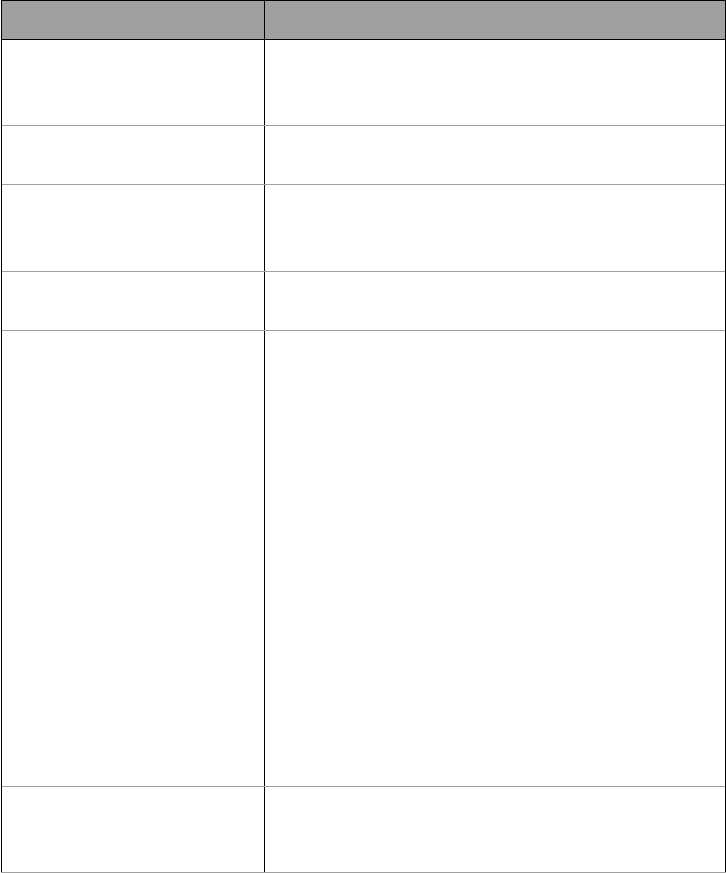
50
Installation
Item Options and descriptions
Projector Position
Chooses the position in which the projector is
installed. See "Choosing a location" on page
21 for more details.
Auto Vertical Keystone
Enables/Disables the projector’s automatic
keystone adjustment.
Vertical Keystone Correction
Allows you to manually adjust the keystone
settings for the projected image. See
"Keystone" on page 34 for more details.
HDMI Format
Selects a suitable color format to optimize
display quality.
Aspect Ratio
There are several options to set the image's
aspect ratio depending on your input signal
source.
• Auto: Scales an image proportionally to
fit the projector's native resolution in its
horizontal or vertical width.
• Real: Projects an image as its original
resolution and resizes it to fit within the
display area. For input signals with lower
resolutions, the projected image will be
displayed in its original size.
• 4:3: Scales an image so that it is displayed
in the center of the screen with a 4:3
aspect ratio.
• 16:9: Scales an image so that it is
displayed in the center of the screen with a
16:9 aspect ratio.
Test Pattern
Displays the test pattern grid, which helps you
adjust the image size and focus to check if
the projected image is free of distortion.

51
Item Options and descriptions
High Altitude Mode
We recommend you use the High Altitude
Mode when your environment is between
1500 m - 2000 m above sea level, and ambient
temperature is between 0°C to 30°C.
Operation under High Altitude Mode may
cause a higher decibel operating noise level
because of increased fan speed necessary
to improve overall system cooling and
performance.
If you use this projector under other extreme
conditions excluding the above, it may display
auto shut-down symptoms, which is designed
to protect your projector from over-heating.
In cases like this, you should switch to
High Altitude Mode
to solve these symptoms.
However, this is not to state that this projector
can operate under any and all harsh or
extreme conditions.
Power Mode
Item Options and descriptions
Normal
100% LED brightness.
Eco
This setting reduces system noise and power
consumption by 30%. If Eco mode is selected,
the light output will be reduced and result in
darker projected pictures.
Low Power Consumption
Lowers brightness to 50% to extend the LED
life.

52
System
Item Options and descriptions
Language
Sets the language for the projector.
Use remote control to power on
Sets to power on the projector via the
power button on the remote control.
Once enabled, the projector scans for
remote control signals when it is powered
off and may drain battery power quickly.
Turn off the Backlight of the
remote control
Displays the tip to turn off remote control
backlight. See "Turning remote control
backlight on/off" on page 20 for more
information.
System Update
Allows you to update the software on
the projector via a USB flash drive. See
"Upgrading your projector" on page 32
for more information.
System Information
Displays hardware/software information
for the projector including its device and
serial number.
Projector Information
Displays information on the current
status of the projector including
the Detected Resolution, Source,
Picture Mode, Power Mode,
Color System, Light Usage Time,
Firmware Version, and Service Code.
Factory Reset
Returns the projector to its factory default
state.
Note
This function resets your projector only. If you wish to
reset your ATV dongle (QS02), perform factory reset
from the Android settings menu.

53
Maintenance
Care of the projector
Your projector needs little maintenance. The only thing you have to do on a
regular basis is keep the lens clean.
Never remove any parts of the projector. Contact your dealer or local
customer service center if the projector fails to operate as expected.
Cleaning the lens
Clean the lens whenever you notice dirt or dust on the surface. Please
be sure to turn off the projector and let it cool down completely before
cleaning the lens.
• Use a canister of compressed air to remove dust.
• If there is dirt or smears, use lens-cleaning paper or moisten a soft
cloth with lens cleaner and gently wipe the lens surface.
• Never use any type of abrasive pad, alkaline/acid cleaner, scouring
powder, or volatile solvent, such as alcohol, benzene, thinner or
insecticide. Using such materials or maintaining prolonged contact
with rubber or vinyl materials may result in damage to the projector
surface and cabinet material.
Note
Never use wax, alcohol, benzene, thinner or other chemical detergents. These can damage the case.
Storing the projector
If you need to store the projector for an extended time, please follow the
instructions below:
• Make sure the temperature and humidity of the storage area are
within the recommended range for the projector. Please refer to
"Specifications" on page 57 or consult your dealer about the range.
• Retract the adjustable feet/kickstand (if available).
• Remove the batteries from the remote control.
• Pack the projector in its original packing or equivalent.
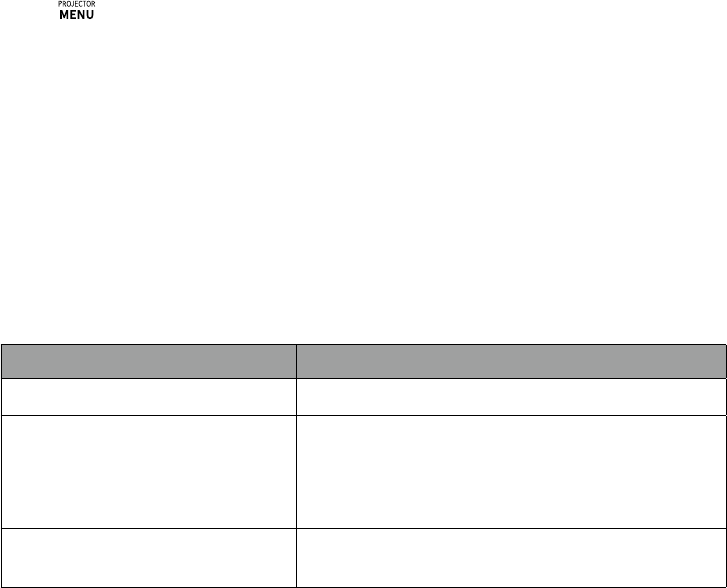
54
Transporting the projector
It is recommended that you ship the projector with its original packing or
equivalent.
Light source information
Go to > System > Projector Information and press OK. The Projector
Information page appears.
Extending LED life
The LED headlight includes a bulb which features a light-source life far
beyond traditional bulbs, yet it is still a consumable item. To keep the LED
life as long as possible, you can change the following settings via the
settings menu.
Go to Power Mode and select a suitable light source mode from among
the provided modes.
Set the projector to Eco or Low Power Consumption mode to extend the
LED life.
Light source mode Description
Normal 100% LED brightness.
Eco This setting reduces system noise and
power consumption by 30%. If Eco mode
is selected, the light output will be reduced
and result in darker projected pictures.
Low Power Consumption Lower its power consumption to 50% to
extend the LED life.

55
Troubleshooting
The LED indicator is flashing.
Scenario LED status
Driver board error
Flashing red/blue
Fan error
Flashing blue/green
Optical engine temperature error
Flashing red
G sensor Error
Flashing red/blue/green
Contact customer service for assistance.
Note
Refer to "Power LED indicator" on page 29 for power LED indicator details.
The projector does not turn on.
Cause Remedy
There is no power from
the power cord.
Plug the power cord into the AC power jack on
the projector, and plug the power cord into the
power outlet. If the power outlet has a switch,
make sure that it is switched on.
Attempting to turn
the projector on again
during the cooling
process.
Wait until the cooling down process has
completed.
No picture.
Cause Remedy
The video source is not
turned on or connected
correctly.
• Check if the video source is properly
connected.
• The projector may be in Audio-only or power
saving mode. Press the power key to disable.
The projector is not
correctly connected to
the input signal device.
Check the connection.
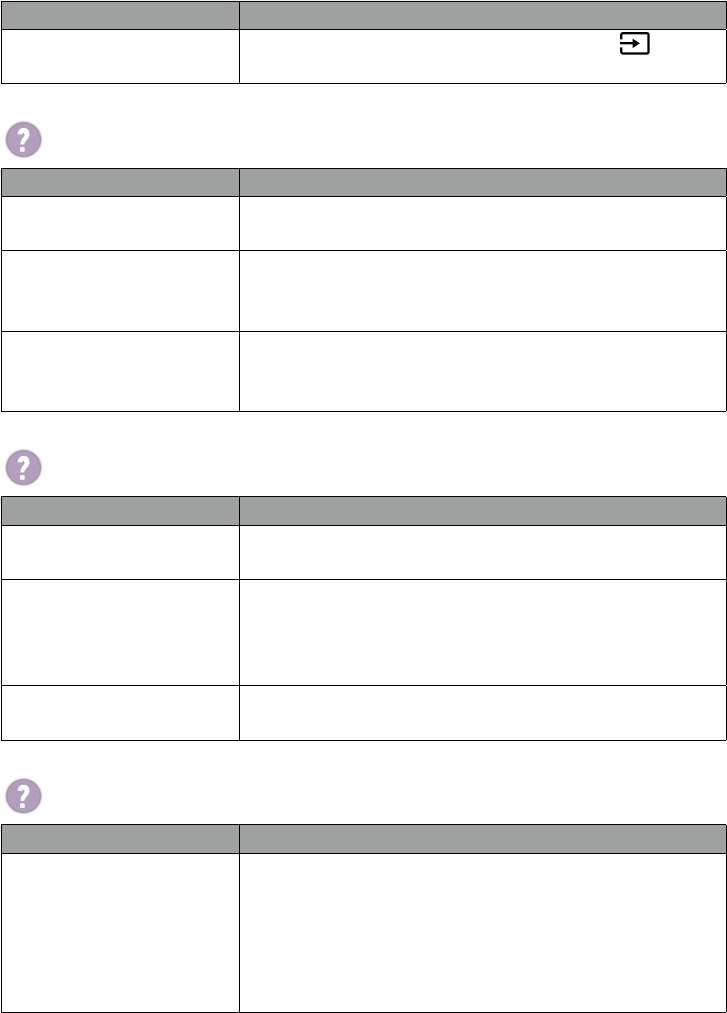
56
Cause Remedy
The input signal has not
been correctly selected.
Select the correct input signal with the
key.
Blurred image
Cause Remedy
The projection lens is
not correctly focused.
Adjust the focus of the lens.
See "Fine-tuning the image clarity" on page 34.
The projector and the
screen are not aligned
properly.
Adjust the projection angle and direction as well
as the height of the projector if necessary.
The auto vertical
keystone function did
not work.
Adjust the projection angle.
Remote control does not work.
Cause Remedy
The batteries are out of
power
Replace both of the batteries with new ones.
There is an obstacle
between the remote
control and the
projector.
Remove the obstacle.
You are too far away
from the projector
Stand within 8 meters (26 feet) of the projector.
Screen brightness adjustment.
Cause Remedy
The screen is not as
bright as expected.
The screen brightness is changed by the light
source mode.
Check the light source mode from Power Mode.
Choose Normal to have the full light source
brightness. Note that this option also consumes
more power than other options.

57
Specications
Projector specications
Category Item Descriptions
Display
Brightness (ANSI lumens) 300
Native Resolution 1080P (1920x1080)
Native Aspect Ratio 16:9
Contrast Ratio (FOFO) 100,000:1
Display Color 24-bit (16.7 million colors)
Light Source LED
Light Source Life
Eco: 30000 hours
Normal: 20000 hours
Optical
Throw Ratio 1.2
Zoom Ratio Fixed
Lens Fixed
Projection Offset (Full-Height) 100%
Keystone Adjustment 1D, (Auto) Vertical ± 40 degrees
Clear Image Size 30"–120"
Picture
Rec. 709 Coverage 98%
Compatibility
Input Lag 45ms (1080p@60Hz)
Resolution Support VGA(640 x 480) to Full HD(1920 x 1080)
Horizontal Frequency 25K – 85KHz
Vertical Scan Rate 22 – 62Hz
HDTV Compatibility 480i, 480p, 576i. 576p, 720p, 1080i, 1080p
I/O Interface
HDMI in
(x2)
HDMI-1 (1.4b/HDCP1.4)
HDMI-Internal (1.4b/HDCP1.4)
USB Type A
(x1)
USB Type A-1 (2.0/Power Supply 1.0A/
Reader)
USB Type C
(x1)
Display Port/ PD in 15V-3A; 20V-2.25A to
3.25A/ PD out 5V-2A, 9V-2A, 12V-1.5A,
15V1.2A
*
/ FW Upgrade
Audio
Speaker
(x2)
4W
Audio out (3.5mm Mini Jack) (x1)
Woofer 8W Chamber

58
Category Item Descriptions
Environment
Power Supply AC 100 to 240 V, 50/60 Hz
Typical Power Consumption 45W@100 – 240VAC
Acoustic Noise (Typ./Eco.)(dB) 28dBA/26dBA
Operating Temperature 0 – 400
Storage Temperature -20 – 60°C, without condensation
Operating Relative Humidity 10 – 90%RH, without condensation
Storage Relative Humidity 10 – 90%RH, without condensation
Battery
Battery Cell Type Lithium-ion
Battery Life
Video Playing Time: approximately 180
mins
Music Playing Time: approximately 300
mins
Battery Life Cycle 500 Cycles
Mechanical Features
Projection angle (Portable only) 135
Smart Features
Bluetooth Bluetooth 5.0
Wi-Fi Standard 802.11a/b/g/n/ac/ax(2.4GHz/5GHz)
Dimensions and Weight
Net Weight (kg) 1.7 kg
Net Weight (lb) 3.7lb
Dimensions (WxHxD) (mm) 131.3(W) x 203.2(H) x 191.4(D)
Dimensions (WxHXD) (inch) 5.2(W) x 8(H) x 7.5(D)
Projections System
Projection System DLP
DMD size 0.23” Pico
Note
• LED life results will vary depending on environmental conditions and usage.
• The performance of Wi-Fi and Bluetooth might be disturbed by distance and obstacles.
• Battery life may vary by the content played, the media source, or the projector settings.
•
*
: PD out is available only when the projector is supplied power by the power adapter came with
your product.
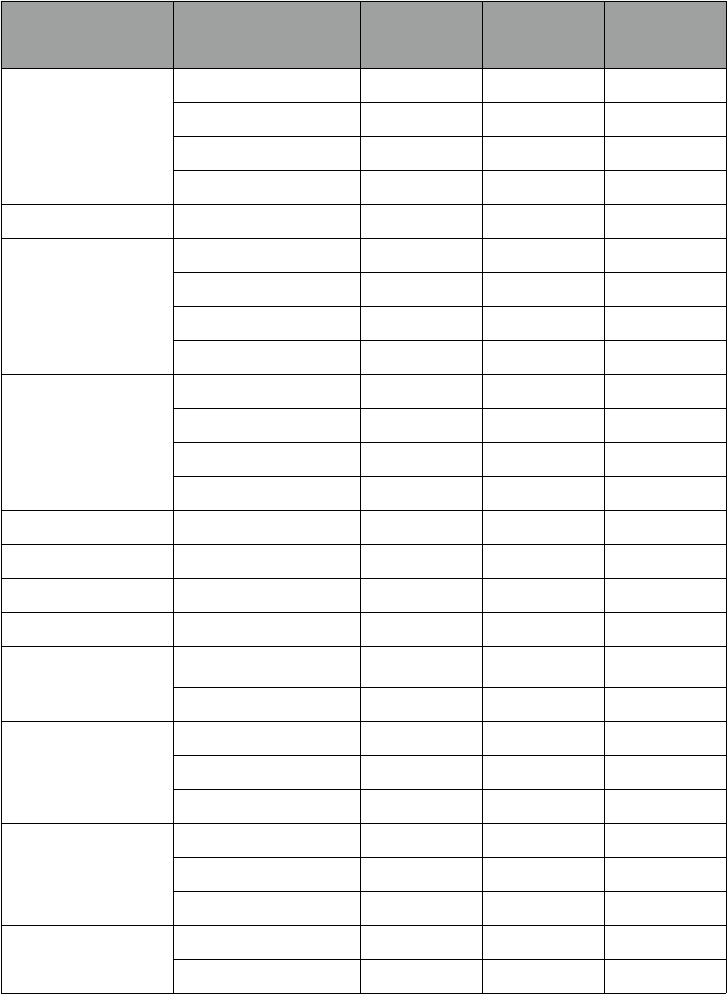
59
Timing chart
Resolution Resolution
Vertical
frequency
(Hz)
Horizontal
frequency
(KHz)
Dot Clock
Frequency
(MHz)
640 x 480
VGA_60 59.940 31.469 25.175
VGA_72 72.809 37.861 31.500
VGA_75 75.000 37.500 31.500
VGA_85 85.008 43.269 36.000
720 x 400 720x400_70 70.087 31.469 28.322
800 x 600
SVGA_60 60.317 37.879 40.000
SVGA_72 72.188 48.077 50.000
SVGA_75 75.000 46.875 49.500
SVGA_85 85.061 53.674 56.250
1024 x 768
XGA_60 60.004 48.363 65.000
XGA_70 70.069 56.476 75.000
XGA_75 75.029 60.023 78.750
XGA_85 84.997 68.667 94.500
1152 x 864 1152 x 864_75 75.000 67.500 108.000
1024x576 BenQ Notebook Timing 60.000 35.820 46.996
1024x600 BenQ Notebook Timing 64.995 41.467 51.419
1280x720 1280 x 720_60 60.000 45.000 74.250
1280 x 768
1280 x 768_60
(Reduce Blanking)
60.000 47.396 68.250
1280 x 768_60 59.870 47.776 79.500
1280 x 800
WXGA_60 59.810 49.702 83.500
WXGA_75 74.934 62.795 106.500
WXGA_85 84.880 71.554 122.500
1280 x 1024
SXGA_60 60.020 63.981 108.000
SXGA_75 75.025 79.976 135.000
SXGA_85 85.024 91.146 157.500
1280 x 960
1280 x 960_60 60.000 60.000 108.000
1280 x 960_85 85.002 85.938 148.500
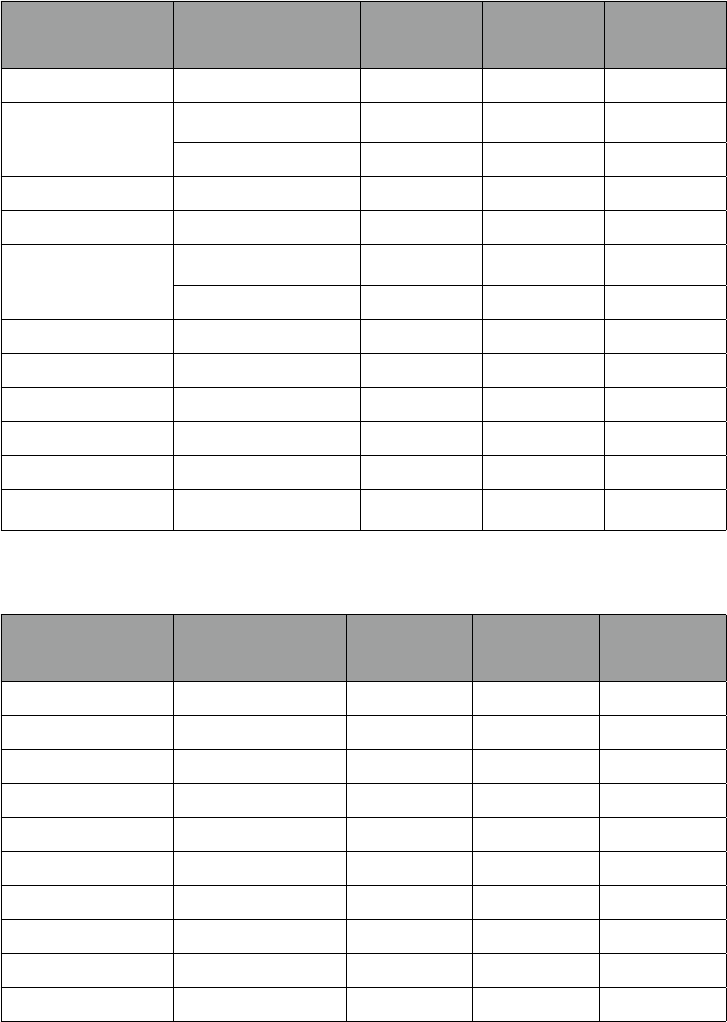
60
Resolution Resolution
Vertical
frequency
(Hz)
Horizontal
frequency
(KHz)
Dot Clock
Frequency
(MHz)
1360 x 768 1360 x 768_60 60.015 47.712 85.500
1440 x 900
WXGA+_60
(Reduce Blanking)
60.000 55.469 88.750
WXGA+_60 59.887 55.935 106.500
1400X1050 SXGA+_60 59.978 65.317 121.750
1600x1200 UXGA 60.000 75.000 162.000
1680x1050
1680x1050_60
(Reduce Blanking)
59.883 64.674 119.000
1680x1050_60 59.954 65.290 146.250
640x480 @67Hz MAC13 66.667 35.000 30.240
832x624 @75Hz MAC16 74.546 49.722 57.280
1024x768 @75Hz MAC19 75.020 60.241 80.000
1152x870 @75Hz MAC21 75.060 68.680 100.000
1920x1080 @60HZ 1920X1080_60 60.000 67.500 148.500
1920X1080
(VESA)
1920X1080_60
(for Auditorium model)
59.963 67.158 173.000
Video timings
Resolution Resolution
Vertical
frequency (Hz)
Horizontal
frequency
(KHz)
Dot Clock
Frequency
(MHz)
480i 720(1440) x 480 15.730 59.940 27.000
480p 720 x 480 31.470 59.940 27.000
576i 720(1440) x 576 15.630 50.000 27.000
576p 720 x 576 31.250 50.000 27.000
720/50p 1280 x 720 37.500 50.000 74.250
720/60p 1280 x 720 45.000 60.000 74.250
1080/24P 1920 x 1080 27.000 24.000 74.250
1080/25P 1920 x 1080 28.130 25.000 74.250
1080/30P 1920 x 1080 33.750 30.000 74.250
1080/50i 1920 x 1080 28.130 50.000 74.250
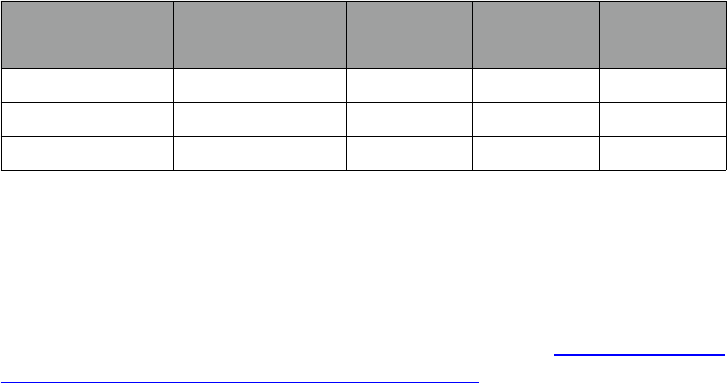
61
Resolution Resolution
Vertical
frequency (Hz)
Horizontal
frequency
(KHz)
Dot Clock
Frequency
(MHz)
1080/60i 1920 x 1080 33.750 60.000 74.250
1080/50P 1920 x 1080 56.250 50.000 148.500
1080/60P 1920 x 1080 67.500 60.000 148.500
Supported le formats
The projector's media reader is powered by the supplied Android TV dongle
QS02. See QS02 user manual from Support.BenQ.com for the supported
file formats.
For details on the supported media formats, please visit: https://developer.
android.com/guide/topics/media/media-formats
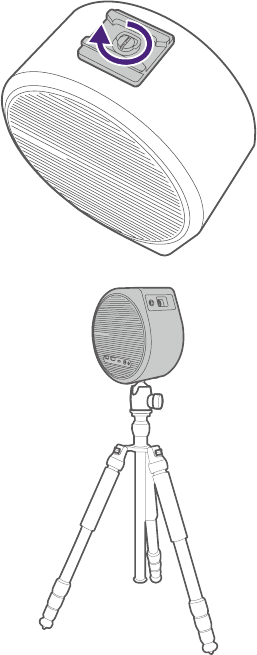
62
Appendix
Working with a tripod (purchased
separately)
Use a tripod plate to mount the projector onto a tripod:
1. Install the tripod’s quick release plate to the projector’s tripod screw
hole and tighten the plate’s screw.
2. Install the projector onto the tripod.
The tripod screw hole on the bottom of your projector is not designed
for ceiling mount installation. If you choose a ceiling location for your
projector, refer to "Front Ceiling" on page 21 and "Rear Ceiling" on page
22 for instructions.
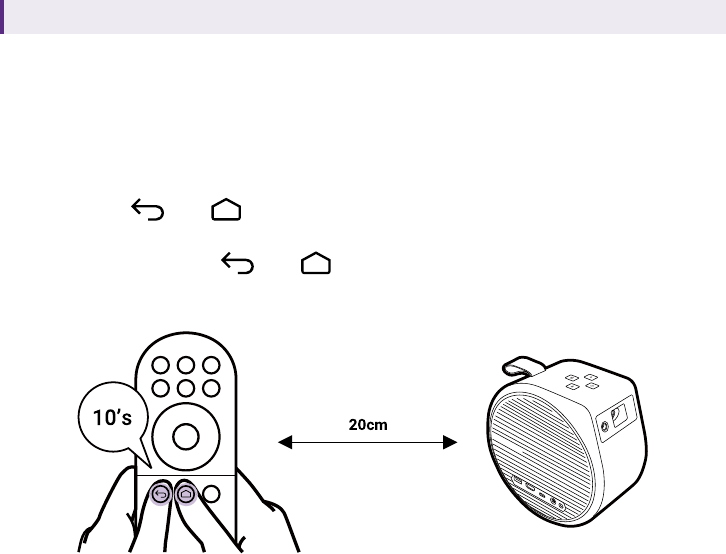
63
Pairing with a new remote control
Compatible BenQ remote control model: RCI077
In case you have received a new remote control from BenQ customer
service, you need to pair it with your projector (with ATV dongle QS02
installed) before use.
1. Make sure the projector (with ATV dongle QS02 installed) is powered
on and the batteries are installed to the remote control.
2. Keep the remote control close to your projector within 20 cm.
3. Press the
and buttons together on the remote control to bring
up the pairing screen.
4. Press and hold the
and buttons together again for 10 seconds
as instructed to start pairing. Follow the on-screen instructions to
complete.
64
Copyright & disclaimer
Copyright
Copyright © 2023 by BenQ Corporation. All rights reserved. No part of
this publication may be reproduced, transmitted, transcribed, stored in a
retrieval system or translated into any language or computer language,
in any form or by any means, electronic, mechanical, magnetic, optical,
chemical,manual or otherwise, without the prior written permission of
BenQ Corporation.
All other logos, products, or company names mentioned in this manual
may be the registered trademarks or copyrights of their respective
companies, and are used for informational purposes only.
Android™ is a trademark of Google LLC.
The Bluetooth® word mark and logos are registered trademarks owned
by Bluetooth SIG, Inc. and any use of such marks by BenQ Corporation is
under license.
iOS is a trademark or registered trademark of Cisco in the U.S. and other
countries and is used under license.
macOS® is a trademark of Apple Inc., registered in the U.S. and other
countries.
Disclaimer
BenQ Corporation makes no representations or warranties, either
expressed or implied, with respect to the contents hereof and specifically
disclaims any warranties, merchantability or fitness for any particular
purpose. Further, BenQ Corporation reserves the right to revise this
publication and to make changes from time to time in the contents hereof
without obligation of BenQ Corporation to notify any person of such
revision or changes. This user manual aims to provide the most updated
and accurate information to customers, and thus all contents may be
modified from time to time without prior notice. Please visit http://support.
benq.com for the latest version of this manual.
It is the sole responsibility of the user if problems (such as data loss and
system failure) occurred due to non-factory installed software, parts, and/
or non-original accessories.

65
Warranty
BenQ warrants this product against any defects in material and
workmanship, under normal usage and storage.
Proof of purchase date will be required with any warranty claim. In the
event this product is found to be defective within the warranty period,
BenQ’s only obligation and your exclusive remedy shall be replacement
of any defective parts (labor included). To obtain warranty service,
immediately notify the dealer from which you purchased the product of
any defects.
Important: The above warranty shall be void if the customer fails to
operate the product in accordance with BenQ’s written instructions,
especially the ambient humidity must be in-between 10% and 90%,
temperature in-between 0°C and 40°C, altitude lower than 2000 meters,
and avoiding to operate the projector in a dusty environment. This warranty
gives you specific legal rights, and you may have other rights which vary
from country to country.
For other information, please visit www.BenQ.com.
Statement regarding hyperlinks and
third-party websites
BenQ is not responsible for the content of the websites or of similar
resources, which are maintained and controlled by third parties, that may
be linked from this product. Providing links to those websites or to similar
resources does not mean that BenQ makes any warranty or representation
to their content by expression or by implication.
Any third party content or service preinstalled in this product is provided
“as is”. BenQ does not, by expression or by implication, make any warrant
to the content or to the services provided by third parties. BenQ does not
warrant or guarantee that the content or services provided by third parties
are accurate, effective, most up-to-date, legal, or complete. Under no
circumstances shall BenQ be liable for the content or services provided by
third parties including their negligence.
Services provided by third parties may be terminated temporarily or
permanently. BenQ does not warrant or guarantee that any content or
services provided by third parties are in good condition at any time, and is

66
not liable for the termination of the said content and services.
In addition, BenQ is not involved in any transactions you conduct in the
websites or similar resources maintained by third parties.
You should contact the content or service providers for any questions,
concerns, or disputes.
BenQ ecoFACTS
BenQ has been dedicated to the design and development of greener
product as part of its aspiration to realize the ideal of the "Bringing
Enjoyment 'N Quality to Life" corporate vision with the ultimate goal
to achieve a low-carbon society. Besides meeting international
regulatory requirement and standards pertaining to environmental
management, BenQ has spared no efforts in pushing our initiatives
further to incorporate life cycle design in the aspects of material
selection, manufacturing, packaging, transportation, using and
disposal of the products. BenQ ecoFACTS label lists key eco-friendly
design highlights of each product, hoping to ensure that consumers
make informed green choices at purchase.
Check out BenQ's CSR Website at http://csr.BenQ.com/ for more
details on BenQ's environmental commitments and achievements.

BenQ.com
© 2023 BenQ Corporation.
All rights reserved. Rights of modification reserved.

